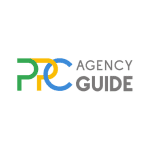
Think about the last time you bought something online. Did you see one ad and click “buy” immediately? Probably not. You likely saw a combination of ads, emails, and posts. In today’s connected world, this scenario plays out constantly, with some consumers interacting with brands hundreds of times before converting. Multichannel marketing allows your brand to be present at every step of their journey. But, what about pay-per-click (PPC) in multichannel marketing specifically? While it can perform well all by itself, it can also be a powerhouse that amplifies the results you see throughout your other marketing efforts. Give us a few minutes, and we’ll walk you through how PPC works with other digital marketing channels and cover a few strategies to help you maximize the benefits.
The Basics of Multichannel Marketing
Multichannel marketing is all about reaching your customers across a variety of platforms, both online and offline. The goal is to create a cohesive experience for your audience, whether they’re interacting with your business through social media, email, paid ads, or even traditional channels like direct mail. It’s about making sure your message is consistent, no matter where your customers encounter your brand.
Why Multichannel Marketing is Important for Your Business
Today’s consumers move across channels throughout their buying journey. They might see an ad on Facebook, click a PPC ad on Google, visit your website, and then read an email before making a purchase. Multichannel marketing allows you to meet them where they are and provide a seamless experience.
Take Starbucks, for example. They use everything from email newsletters and mobile app notifications to PPC and social media to keep their audience engaged. By doing this, they’re not relying on just one channel to drive sales, but ensuring customers are reminded of promotions or products across multiple touchpoints.
For your business, adopting a multichannel strategy means diversifying your efforts, so you’re not putting all your eggs in one basket. It’s the difference between being seen once and being remembered. Done right, it can increase engagement, brand awareness, and ultimately drive higher conversions.
The Role of PPC in Multichannel Marketing Strategies
In any multichannel marketing strategy, PPC plays a critical role in ensuring your brand doesn’t just reach a broad audience but connects with the right people at the right time. This channel is uniquely positioned to complement and enhance the performance of other marketing efforts. Here’s why PPC is such a powerful component of a multichannel approach.
Immediate Visibility and Traffic Generation
PPC gives your business a fast lane to the top of search results or other platforms like social media or display networks, even if you’re still building your organic presence. Unlike search engine optimization (SEO), which can take months to show results, PPC ads are instant. Once your campaign is live, your business is out there. This is especially helpful if you’re launching a new product or running a limited-time promotion and need immediate traffic.
Targeting Specific Audiences
PPC allows you to laser-focus your advertising efforts by targeting specific audience segments. You can bid on keywords that align with your customer’s search intent and target ads by demographics, location, device type, and even behavioral data. This precision targeting is crucial in a multichannel strategy because it ensures your brand is visible to the right people at the right time.
Enhancing Brand Awareness
PPC isn’t just for direct conversions. It’s also a powerful tool for increasing brand awareness, especially when combined with other channels. Options such as display ads, video ads, and even text ads can keep your business top of mind. You can use PPC to introduce your brand to potential customers before they even start searching for your products or services.
Pairing PPC and SEO
One of the biggest advantages of PPC is its ability to complement SEO, helping your business get noticed even as you build long-term organic traffic. SEO is a long game. It involves optimizing your website so it ranks organically for relevant search terms. While it’s essential for sustainable traffic, SEO can take months—sometimes even longer—to see meaningful results, especially if you’re in a competitive industry where top keywords are dominated by well-established businesses.
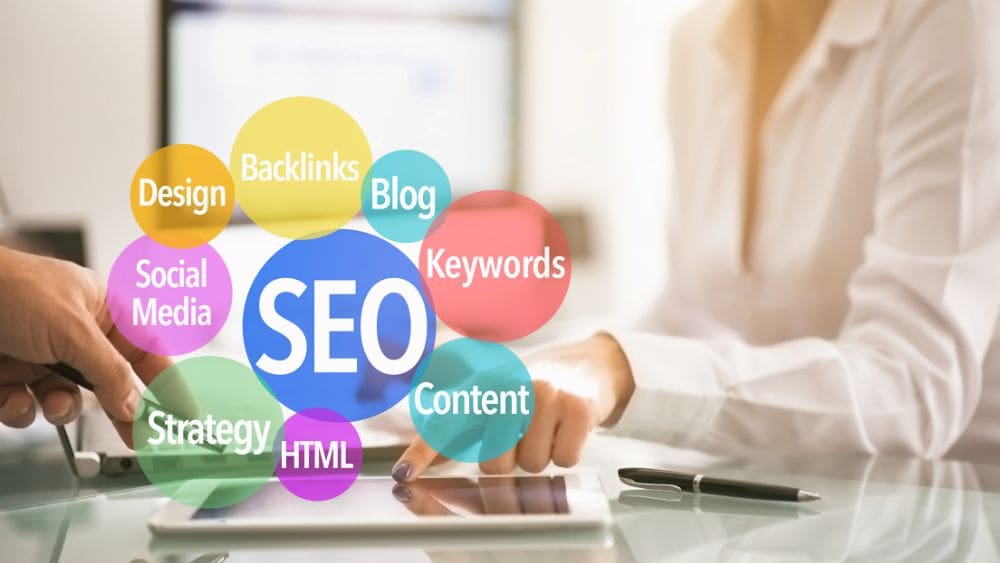
This is where PPC steps in. With PPC, you can immediately place your business at the top of search results for those highly competitive keywords, even if your organic ranking isn’t strong yet. PPC ads appear above the organic results, giving you a chance to drive traffic to your site while you continue building your SEO efforts in the background.
For example, if you’re in the legal services industry, ranking organically for keywords like “personal injury lawyer” could take years due to the intense competition. A PPC ad for that same keyword, however, can get your business visibility right away. In this case, PPC ensures you’re not missing out on traffic while you’re working to climb the organic ranks.
Impact on Search Engine Results Page Real Estate
When you combine both PPC and SEO, you increase your chances of dominating the search engine results page (SERP). PPC ads typically occupy the top of the page, with organic listings appearing below them. By securing both an ad placement and an organic result, your business takes up more space on the page, which can significantly boost visibility and credibility.
Why Combining SEO and PPC Matters
Users trust organic results but are also more likely to click on a PPC ad if it appears relevant. If your business appears in both, you’re reinforcing your presence and improving the likelihood of getting the click.
Take Amazon, for example. They often show up in both paid and organic results for product searches, ensuring that they dominate the SERP. For smaller businesses, securing both positions can be just as valuable, as it signals to users that your brand is authoritative and trustworthy.
Using PPC to Test Keywords for SEO Strategies
While retargeting helps re-engage users and boost conversions, PPC also plays an essential role in shaping your long-term SEO strategy. One of the most effective ways to refine your SEO efforts is by using PPC campaigns to test keywords. Since SEO requires a significant investment of time and resources, PPC helps you focus on the right keywords—the ones that will actually drive traffic and conversions.
With PPC, you can run campaigns for a variety of keywords and monitor which ones bring in the most traffic, generate leads, or convert to sales. The data from your PPC campaigns gives you actionable insights into which keywords are worth optimizing for organically. You can see which terms are highly searched, have high conversion rates, or result in the best return on investment (ROI).
For example, let’s say you’re a local HVAC business and you’re debating between targeting “air conditioning repair near me” or “HVAC services in [city name]” for SEO. You can run short-term PPC campaigns for both phrases and compare the performance. If “air conditioning repair near me” drives more conversions, that’s a strong indicator it’s worth focusing on in your SEO strategy.
By using PPC as a testing ground, you avoid wasting months or even years optimizing for the wrong keywords. It’s like getting a cheat sheet for your SEO efforts, ensuring that every dollar and hour spent is targeted and effective.
Combining PPC and Social Media Advertising
After harnessing the power of PPC and SEO to dominate search engines, it’s essential to extend your reach to where your audience spends a significant portion of their time: social media. PPC and social media advertising work hand-in-hand to deliver a unified customer experience. While PPC primarily targets users through search engines and display networks, social media ads allow you to reach users in their social feeds. Together they offer a powerful way to guide customers through a cohesive journey.

How PPC Works Alongside Social Ads for a Cohesive Customer Journey
A well-rounded marketing strategy leverages both PPC and social media ads to connect with customers at different stages of their journey. For instance, someone might first discover your business through a Google search ad, click on it, but not convert. Later, they might see a Facebook ad that reinforces your message or offers a promotion, nudging them closer to making a decision.
By coordinating your messaging across PPC and social ads, you create a seamless experience for users as they move from one platform to another. The key is consistency—ensuring that the tone, messaging, and visuals align across all channels so that users see your brand as a cohesive whole.
Integrating Facebook/Instagram Ads and Google Ads for Broader Audience Reach
Combining Google Ads with Facebook and Instagram ads allows you to reach users across both search and social media platforms, which expands your overall audience reach. Google Ads capture people actively searching for products or services, while social media ads reach users based on their demographics, interests, and behavior, often when they’re not actively searching for your product.
To choose the right platforms for your business, it’s important to compare major display ad networks based on their targeting capabilities, ad formats, and audience reach. Understanding how these display ad networks differ helps to ensure your multichannel strategy is both efficient and effective.
Let’s say you’re a fitness apparel brand. With Google Ads, you can target users searching for “best running shoes” or “gym leggings.” Meanwhile, with Facebook and Instagram ads, you can target users who have shown interest in fitness, health, and wellness through their activity on social media. By integrating both, you’re covering both the intent-driven and interest-driven parts of the funnel.
This approach helps you move users through the entire customer journey:
- Google Ads capture their attention when they’re ready to search and buy.
- Facebook/Instagram ads engage users with visually appealing content during their downtime, reminding them of your brand.
For example, a business like Warby Parker may run Google Ads targeting searches for “affordable prescription glasses,” while simultaneously running Facebook and Instagram ads showcasing trendy glasses models, promotions, or customer testimonials. The combination ensures they are visible across multiple touchpoints, increasing the likelihood of conversions.
Retargeting ensures that no potential customer slips through the cracks. By using PPC to retarget visitors from other channels like email or social media, you’re increasing your chances of conversions by staying top-of-mind.
Cross-channel retargeting amplifies your impact. By integrating PPC with social media ads, you create a holistic strategy where each channel reinforces the other, guiding your audience through a seamless customer journey.
Combining PPC with social media advertising offers broader audience reach. With Google Ads targeting search intent and Facebook/Instagram ads reaching users through interest-based targeting, you’re covering multiple points in the sales funnel for greater conversions.
Using PPC to Amplify Content Marketing
Just as PPC and social media can work in harmony to guide customers through a cohesive journey, PPC also amplifies another critical element of your digital strategy—content marketing. Content marketing focuses on creating valuable, informative, or entertaining content to engage your audience, build trust, and generate leads. However, creating great content alone isn’t enough. If people aren’t finding or engaging with it, your efforts can go unnoticed. That’s where PPC advertising comes in—it helps promote your content to the right audience at the right time, amplifying its reach and impact.
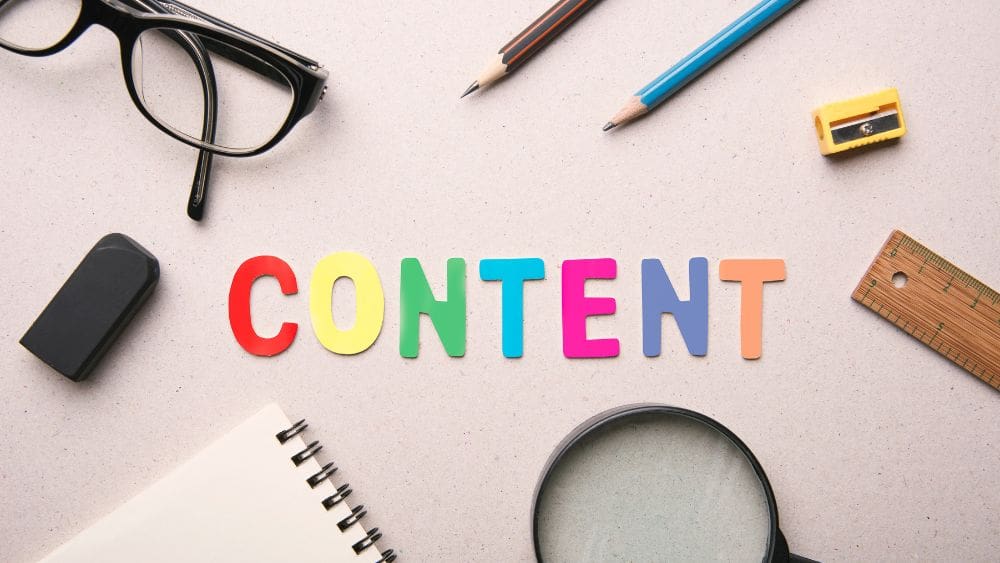
Promoting Blog Posts, Webinars, and eBooks Through PPC
One of the simplest ways to use PPC to boost your content marketing is by promoting your high-value content pieces—such as blog posts, webinars, whitepapers, or eBooks—through paid ads. By targeting the right keywords and audiences, you can drive relevant traffic to your content and ensure it reaches the people who are most likely to engage with it.
For example, if you’ve written a blog post on “how to scale a small business,” you can create Google Ads or Facebook ads that target small business owners or entrepreneurs searching for growth strategies. By directing these users to your blog, you’re positioning your business as a thought leader while also increasing the likelihood of conversions down the line.
A great example is HubSpot, which promotes its free resources—like eBooks and webinars—through Google Ads. By doing so, they drive traffic to their content, collect leads, and nurture them over time through email and additional marketing efforts.
Driving Traffic to Lead Magnets
Lead magnets, such as free eBooks, checklists, or webinars, are essential for capturing leads. PPC is an effective way to promote these lead magnets by targeting specific audience segments that would find value in them. You can create ads that direct people to a landing page where they can download the lead magnet in exchange for their email address or other contact information.
For example, let’s say you’re a B2B SaaS company offering a free whitepaper on improving team productivity. You can use LinkedIn ads to target decision-makers in companies that match your ideal customer profile (such as HR managers or operations leaders) and direct them to your whitepaper landing page. The PPC campaign helps you gather qualified leads who are already interested in improving productivity, setting the stage for further engagement.
Boosting Content Visibility Beyond Organic Reach
Even the best content can struggle to gain traction through organic search or social media, especially if it’s a competitive topic. PPC can bridge the gap by giving your content the visibility it needs while your SEO efforts work in the background.
For instance, Facebook and Instagram ads allow you to promote blog posts, videos, or other types of content directly to users based on their interests, behaviors, and demographics. If you’ve created a video about “sustainable business practices,” but your organic reach isn’t cutting through, a PPC campaign can get your content in front of the right people, ensuring it doesn’t get lost in the noise.
A company like Airbnb often promotes user-generated content, like blog posts and videos featuring real customers, through social media ads. This not only amplifies the reach of the content but also enhances brand trust by showcasing real experiences.
Reaching a Targeted Audience with Precision
PPC allows you to target very specific audiences who are most likely to engage with your content. Whether through Google Ads, LinkedIn, or social media platforms like Facebook and Instagram, you can set up campaigns that reach users based on:
- Keywords they’re searching for.
- Demographics, such as age, location, and profession.
- Interests and behaviors, such as people interested in marketing tools or sustainable products.
- Retargeting to those who’ve interacted with your content previously.
For example, if your business targets financial services professionals, you can use LinkedIn ads to promote your content to users in specific roles, such as CFOs or financial advisors, or within certain industries. This ensures that your content is not only being seen but is being seen by the right people—those who are most likely to engage with it and, eventually, convert into leads or customers.
Using PPC to Drive Traffic to Gated Content
If you’re offering gated content like an eBook, whitepaper, or video course, PPC can be particularly effective in driving high-quality traffic to the gate, where users must provide their contact information to access the content. This strategy is commonly used in B2B marketing, where lead generation is crucial.
For instance, if you’re hosting a webinar on “cutting-edge marketing strategies,” you can run Google search ads targeting relevant keywords such as “best marketing strategies”) or LinkedIn ads targeting professionals in marketing roles. The ad would direct users to a landing page where they can register for the webinar by providing their email, thus generating qualified leads.
Companies like Salesforce often use this strategy to promote their thought leadership content, offering access to premium reports or webinars in exchange for email signups, which helps them build a robust lead pipeline.
Measuring the Effectiveness of Content Amplification
Now that you’ve amplified your content with PPC and re-engaged potential customers through retargeting, the next step is to ensure these efforts are delivering results. PPC also allows you to track the effectiveness of your content promotion efforts in real-time. By measuring metrics like CTR, conversion rates, and cost per conversion, you can assess whether your content is resonating with your audience and whether you’re getting a strong ROI.
For example, if your PPC campaign promoting a blog post isn’t generating many clicks, you can adjust your ad copy, targeting, or even the content itself. If the content is driving traffic but not conversions, you may need to optimize your landing page or call to action (CTA).
Why Using PPC to Amplify Content Marketing Matters for Your Business
- Increase Visibility: PPC ensures your content gets seen by the right people, overcoming the limitations of organic reach.
- Drive Engagement and Leads: By promoting high-value content like eBooks, webinars, or whitepapers, you can capture leads who are already interested in what you offer.
- Target Precisely: PPC allows you to focus on specific audience segments, ensuring that your content reaches the people most likely to engage and convert.
- Measure Performance: With PPC, you can track how your content performs and make adjustments to improve its effectiveness.
Leveraging PPC and Retargeting
Retargeting is one of the most powerful tools in PPC, enabling you to reconnect with users who have already interacted with your brand across multiple channels—whether they visited your website, clicked on an ad, or engaged with a social media post. Retargeting ensures you stay top-of-mind for potential customers who showed interest but didn’t convert the first time around.
By leveraging retargeting, you can serve tailored PPC ads that remind users of products they viewed, abandoned carts, or content they engaged with. Retargeting isn’t limited to just one platform. It works across search engines, social media, and display networks, guiding users through their buying journey until they’re ready to convert. This cross-channel strategy ensures that no opportunity is missed, maximizing the impact of your multichannel efforts.
Using PPC for Retargeting to Site Visitors from Other Channels
PPC ads aren’t just for acquiring new customers. They’re crucial for converting visitors who’ve already interacted with your brand through other channels. For example, someone might open one of your marketing emails or click a link from your social media post, browse your site, but leave without making a purchase. With retargeting, you can target these visitors with tailored PPC ads as they browse other websites or search on Google, reminding them of the products they viewed.
This cross-channel synergy is essential because it takes multiple touchpoints to convert most customers. For instance, it takes six to eight touches to generate a sales lead, according to Salesforce. Equally, some customers can have hundreds of touchpoints before converting, Google reports. Retargeting ensures that people who’ve engaged with your business previously don’t forget about you.
Cross-Channel Retargeting Strategies to Increase Conversions
Retargeting isn’t limited to just one platform. A key aspect of a multichannel strategy is cross-channel retargeting, where you serve ads to potential customers across multiple platforms. This creates a more cohesive and consistent experience, ensuring your brand stays visible no matter where users spend their time. For instance, someone might see your Google retargeting ad while browsing a blog and later encounter a related Facebook or Instagram ad while scrolling through their feed.
This strategy works because it keeps your brand in front of users as they move across platforms. It’s particularly effective for high-ticket items or longer sales cycles, where users need more time to make a decision. By serving them ads in different contexts, such as search engines, social media, and YouTube, you stay top of mind throughout their journey.
For example, a business selling high-end furniture might show a Google retargeting ad after a visitor browses a product page. Later, a Facebook retargeting ad for the same product could offer a special discount, increasing the chances of conversion.
Cross-Channel Attribution and Measurement
Customers rarely convert through a single touchpoint. They might first discover your business through a PPC ad, sign up for your email list after reading your blog, and later make a purchase after seeing a retargeting ad on Facebook. Tracking how PPC contributes to this journey is critical because it helps you understand how each channel plays its part in driving conversions.
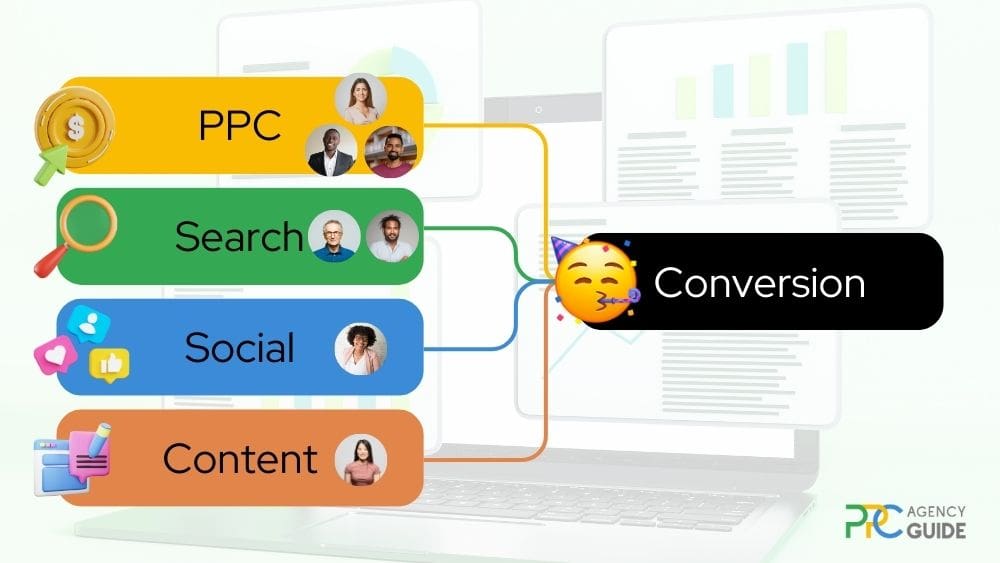
By using tools like Google Analytics, you can track how users interact with your PPC ads and what they do next. Did they click through your ad and browse your website? Did they sign up for a webinar? This data gives you a clear picture of PPC’s role in the customer journey and helps you allocate resources to the right areas.
For example, if you run a B2B SaaS company, tracking might reveal that many users click on a Google Ad, or browse your product page, but don’t sign up until after receiving a follow-up email. Knowing this allows you to adjust your strategy—perhaps by retargeting users who’ve clicked on your PPC ads but haven’t converted, or by adjusting your messaging across channels to be more consistent.
How PPC Data Can Provide Insights for Other Marketing Channels
The data you collect from PPC campaigns can be incredibly valuable for optimizing other marketing channels. Since PPC campaigns provide near-instant feedback, you can gather insights like:
- Which keywords and messages drive traffic and conversions?
- Which audience segments respond best to your ads?
- What times of day or days of the week generate the highest engagement?
This data doesn’t just benefit PPC—it can inform your entire marketing strategy. For instance, if you find that a particular set of keywords drives the most conversions, you can use that insight to refine your SEO, content marketing, or even email campaigns. If certain audience segments respond well to your PPC ads, you can focus more on those segments across other platforms, such as social media or email marketing.
For example, HubSpot often uses PPC data to optimize other channels. If their ads targeting small businesses in specific industries perform well, they might use that insight to tailor blog content or webinar topics to those same industries. This creates a more cohesive and targeted marketing effort across all platforms.
Attribution Models
As you refine your PPC strategy through testing and optimization, it’s equally important to understand how PPC contributes to your overall marketing success. This is where attribution models come in. When it comes to tracking the effectiveness of PPC and other channels in the customer journey, attribution models help you assign credit to each touchpoint along the way. There are several different models, each providing a unique perspective on how conversions happen.
First-Click Attribution
This model gives all the credit to the first touchpoint that introduced the customer to your business. If a user clicked on your PPC ad first but converted after receiving several emails, all the credit would go to the PPC ad. First-click attribution is helpful for understanding which channels are driving initial awareness.
For example, a customer sees a Microsoft Ad for your online clothing store, clicks through, but doesn’t buy. They later return through email or organic search and make a purchase. First-click attribution would give full credit to the Microsoft Ad.
Last-Click Attribution
This is the most commonly used model and gives all the credit to the last touchpoint before conversion. If the final action a customer took before converting was clicking a retargeting PPC ad, that ad would get 100 percent of the credit.
For instance, a customer clicks on your ad, browses your website, but leaves without purchasing. Later, they return to the site directly and make a purchase. With last-click attribution, the direct visit gets all the credit, even if the PPC ad introduced them to your site initially. This can sometimes undervalue PPC’s role in the earlier stages of the journey.
Linear Attribution
This model distributes credit evenly across all touchpoints that contributed to the conversion. If a customer interacted with your PPC ad, an email, and an organic blog post before purchasing, each of those touchpoints would receive equal credit.
Picture a customer who clicks your PPC ad first, then signs up for a newsletter, and finally buys through a link in your email campaign. In linear attribution, all three channels get an equal share of the credit, offering a more balanced view of the journey.
Time-Decay Attribution
This model gives more credit to the touchpoints closest to the conversion. So if a customer clicked on your PPC ad early in the journey but made a purchase after clicking an email, the email gets more credit, while the PPC ad receives less, though it still plays a role.
For example, a customer clicks your PPC ad two weeks before purchasing but later returns via a Facebook ad to buy. In a time-decay model, the Facebook ad gets more credit than the PPC ad because it was closer to the conversion, but both play a part.
Position-Based Attribution (U-Shaped Model)
In this model, 40 percent of the credit goes to the first and last touchpoints, while the remaining 20 percent is divided among the middle interactions. This is a great way to give proper credit to both the introduction and the final conversion point, while acknowledging the journey as a whole.
For instance, a customer clicks a PPC ad, reads a blog post, and converts through an email campaign. The PPC ad and email would each get 40 percent of the credit, with the blog post getting 20 percent.
Why This Matters for Your Business
Knowing which attribution model to use is essential because it informs how you allocate your budget across marketing channels. If you’re only using last-click attribution, you might over-invest in channels that close the deal, like email or retargeting ads, and under-invest in PPC ads that bring in fresh leads. By understanding how PPC contributes throughout the customer journey, you can make smarter decisions about where to focus your resources.
Budget Allocation and Channel Synergy
Once you’ve understood how PPC contributes to your customer journey through proper attribution, the next step is ensuring that your budget is allocated strategically across your marketing channels. When you’re running a multichannel strategy that includes PPC, SEO, social media, email marketing, and other forms of outreach, knowing how to allocate your budget effectively across these channels is critical. Each channel serves a different role in the customer journey, and when they work together seamlessly, it can lead to higher conversions and more efficient spending.
How to Allocate Budgets Across PPC and Other Channels
Each channel in your marketing strategy—whether it’s PPC, social media, or email marketing—comes with its own strengths and budgetary needs. Here’s how you can approach budget allocation.
PPC
This channel often gets a large share of the budget because it offers immediate visibility and results. For businesses that need to drive traffic or conversions quickly, PPC is essential. If you’re launching a new product or running a time-sensitive promotion, you’ll likely want to allocate more funds to PPC to ensure your ads are seen by a large audience.
For example, in eCommerce, it’s common for businesses to allocate up to 40 percent of their digital ad budget to PPC, especially during high-conversion periods like the holidays.
SEO
SEO tends to be a long-term investment that requires consistent effort over time. While it doesn’t demand a large upfront budget like PPC, it does need ongoing resources for content creation, optimization, and link building. Many businesses allocate a smaller portion of their budget to SEO, knowing that the payoff may come months down the road.
Social Media
For businesses with highly visual products or those targeting specific demographics, social media ads (Facebook, Instagram, LinkedIn) can be very effective. While the cost per click (CPC) on social media is often lower than on Google, the reach can be broad. Businesses might allocate ten to 20 percent of their budget to social media ads, but this varies based on the nature of the business and audience.
Email Marketing
Email marketing is often the most cost-effective channel, but it still requires investment, especially for automation tools and professional design. Many businesses allocate a smaller percentage, often around five to ten percent, of their budget to email marketing, but the return on investment (ROI) can be substantial due to its direct line to existing customers.
Adjusting PPC Spend Based on Channel Performance
One of the great things about PPC is that it’s highly flexible. If you notice that certain channels are underperforming or that PPC is driving more conversions than, say, organic social media posts, you can quickly adjust your budget in real-time.
For example, if your SEO strategy is still in its early stages, you may want to increase your PPC spend to ensure your business remains visible in search results while waiting for organic rankings to improve.
If social media ads are generating high engagement but low conversions, you might shift funds toward PPC, where you can target more intent-driven users.
By constantly monitoring your customer acquisition cost (CAC) and return on ad spend (ROAS) for each channel, you can reallocate resources to where they’ll be most effective. This agile approach ensures you’re not locked into any one strategy and can pivot quickly as results come in.
Creating Synergy Between PPC and Other Channels
The key to a successful multichannel strategy is ensuring that all channels work together cohesively. Here’s how to create synergy between PPC and other channels.
PPC and SEO
Use PPC ads to supplement SEO for highly competitive keywords. You can dominate SERPs by having both an ad and an organic listing appear for key search terms, effectively doubling your chances of a click.
PPC and Social Media
Run cross-channel campaigns that engage customers across multiple touchpoints. For instance, someone might see your brand’s Google ad while searching for a product, then later encounter a retargeting ad on Instagram reminding them of that product. By aligning messaging across platforms, you create a consistent experience that reinforces brand recognition.
For instance, a fitness brand might target users with a Google ad for “best yoga mats,” and then retarget those same users with a Facebook ad showing a video of their yoga mats in action.
PPC and Email Marketing
Use PPC to bring in new leads and direct them to an email opt-in page, where you can capture their information and nurture them with email campaigns. This strategy ensures that you’re not just driving traffic but also converting that traffic into long-term relationships via email marketing.
PPC and Content Marketing
Use PPC to amplify your content marketing efforts. For example, if you’ve published a new blog post or eBook, you can promote it through PPC ads to increase visibility and drive more traffic to your content. Once those users land on your site, you can use retargeting to entice them with more specific offers.
Data Sharing Across Channels
To truly optimize a multichannel strategy, effective data sharing is crucial. After allocating your budget across different channels, the next step is ensuring your teams are leveraging data from each platform to inform decisions and drive performance. In a multichannel marketing strategy, data sharing refers to the process of gathering, analyzing, and using data across different marketing platforms and campaigns. By sharing insights from PPC campaigns with other channels, you create a more informed and cohesive strategy that maximizes performance across the board.
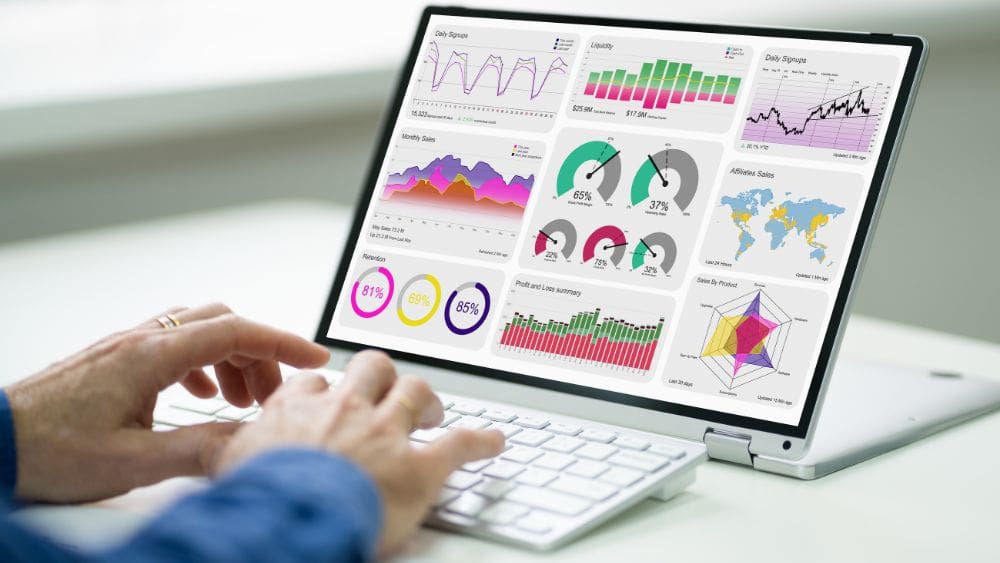
How PPC Data Provides Insights for Other Channels
PPC campaigns generate valuable data on audience behavior, keyword performance, and conversion trends. This data can be applied to improve the performance of other channels in your marketing mix. Here are some ways PPC insights can inform other areas:
Keyword Insights for SEO
PPC campaigns give you real-time feedback on which keywords are driving traffic and conversions. You can use these insights to optimize your SEO strategy, focusing on keywords that show strong performance in paid campaigns. If a keyword is generating high-converting traffic through PPC, it’s a good indication that it’s worth targeting organically as well.
For example, if a PPC campaign for a law firm shows that the “best personal injury lawyer” is driving conversions, this keyword should be prioritized in SEO efforts to capture organic traffic as well.
Audience Segmentation for Social Media
PPC platforms, like Google Ads and Facebook Ads, allow you to test different audience segments and see which ones respond best to your ads. This data can inform your social media targeting by identifying the demographics, interests, or behaviors that yield the highest engagement and conversions.
Let’s say a PPC campaign for a fitness brand reveals that men aged 25-34 are most likely to click and convert. You can apply this insight to your social media campaigns, creating content and ads that specifically appeal to this group.
Content Personalization in Email Campaigns
PPC data can also help refine your email marketing strategy. If certain messages or CTAs perform well in PPC ads, those insights can be used to tailor email copy and offers. Similarly, you can segment your email lists based on behaviors captured from PPC campaigns, such as targeting email content to users who clicked on a specific ad.
For example, if your PPC ads for financial services emphasize a free consultation and perform well, you might use a similar offer in your email marketing to encourage sign-ups or conversions.
Aligning Messaging and Offers Across Channels
One of the biggest benefits of data sharing across channels is that it allows you to align your messaging and offers consistently. A potential customer might interact with your business through PPC, SEO, social media, or email, so it’s important that your message remains consistent across all touchpoints.
For instance, if a PPC campaign promotes a ten percent discount on a product, your email marketing and social media ads should reflect the same offer. Using PPC data, you can see how well a particular offer resonates with your audience and adjust your messaging in other channels accordingly.
Consistency not only improves your brand’s credibility but also ensures that your customers don’t get confused by different messages, helping to build trust throughout their journey.
Using Google Analytics and PPC Data for Cross-Channel Insights
Tools like Google Analytics allow you to track user behavior across your website, giving you insights into how visitors interact with your content after clicking a PPC ad. This data can be shared across teams to improve performance in other channels.
For example, path exploration in Google Analytics shows how users navigate through your site after landing from a PPC ad. If you see that many users are dropping off after viewing a certain page, you might optimize that page or your overall site structure to improve engagement across all channels.
Conversion Reports help you understand which sources and channels contribute to conversions. If PPC is driving a lot of first-time visitors, but email marketing is closing the deal, you can use this insight to further refine your multichannel strategy.
This integration between PPC data and Google Analytics also helps with understanding the customer journey and identifying where to focus your efforts, whether it’s optimizing landing pages, creating better email sequences, or improving user flow through your site.
Optimizing Cross-Channel Campaigns Based on PPC Data
PPC data offers key insights into what’s working and what’s not, allowing you to optimize campaigns across all channels. For example:
- If a certain ad copy performs well in PPC, you can repurpose that copy for organic social posts, blog headlines, or email subject lines.
- If a PPC ad is driving a high volume of traffic but few conversions, you might adjust your landing page content to better align with the ad, or you could test similar CTAs in email and social media campaigns.
By continuously sharing data between channels, you ensure that every part of your strategy benefits from the insights gained in PPC campaigns.
Cross-Channel Retargeting Based on PPC Data
PPC retargeting data can help guide your retargeting efforts across other platforms, such as social media and email marketing. By analyzing how users engage with your ads, you can segment audiences and create more personalized retargeting campaigns on other platforms.
For example, if users click on your PPC ad for a free trial offer but don’t convert, you can use that data to create a Facebook retargeting campaign offering them a follow-up discount or additional content to entice them back. Similarly, you can send an email reminder to those same users, further nurturing them toward conversion.
Brands like ASOS use cross-channel retargeting to follow users from Google search ads to social media platforms like Instagram and Facebook, where they show relevant offers and content tailored to the user’s previous interactions.
Creating a Unified View of the Customer Journey
Data sharing across channels gives you a more unified view of the customer journey, helping you understand how users interact with your brand at various stages. This holistic approach helps ensure that each marketing channel is supporting the others, rather than operating in silos.
By integrating PPC data with other channel insights, you can identify patterns in how customers move through your funnel. For example:
- You might find that users who click on PPC ads tend to engage more with email marketing after visiting your site.
- Or, you could discover that organic social media traffic leads to users who are more likely to convert through a Google search ad later in the journey.
Having this unified view allows you to make smarter decisions about where to allocate budget, how to tailor your messaging, and where to focus your optimization efforts.
Why Data Sharing Across Channels Matters for Your Business
- Better Insights: Sharing PPC data across channels gives you a more complete view of your audience, allowing you to optimize your efforts across all marketing platforms.
- Consistent Messaging: Aligning offers and messaging across channels helps create a seamless experience for customers and builds trust.
- Increased Efficiency: By leveraging data from PPC campaigns, you can optimize content, offers, and targeting across other channels, improving overall performance.
- More Informed Decisions: Data-driven insights help you allocate resources more effectively, ensuring that each channel contributes to the broader marketing strategy.
Make the Most of PPC in Multichannel Marketing
As you can see, there are countless benefits to leveraging PPC in multichannel marketing, particularly if you know how to create synergy between paid advertising and other channels. Unfortunately, this is an area most in-house teams, and even some PPC agencies, struggle with. If you’d like to make the most of PPC in multichannel marketing, allow us to match you with an experienced agency that can help. Request a complimentary consultation to get started.
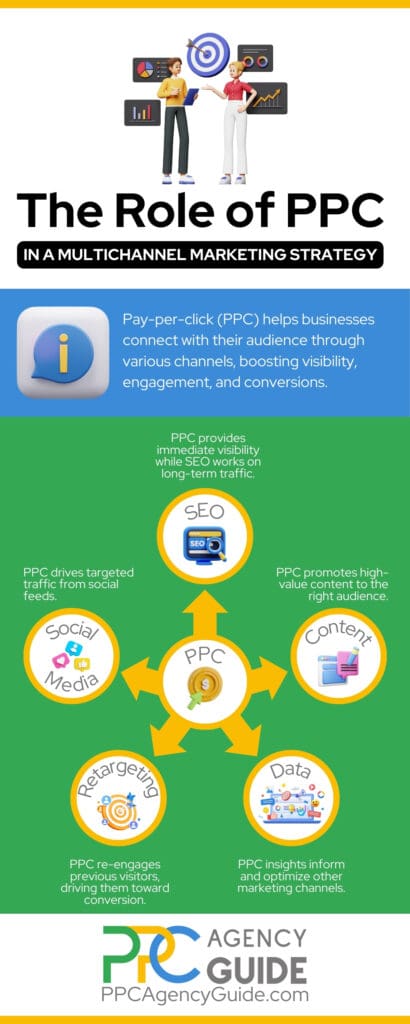
FAQs on PPC in Multichannel Marketing
What is the difference between PPC and SEO in digital marketing?
PPC provides immediate, paid search visibility, while SEO focuses on organic ranking through content and website optimization. PPC results are immediate but temporary, as ads disappear once the budget is spent. SEO takes longer to show results but provides lasting visibility, making both essential for a balanced strategy.
How can PPC and SEO work together to improve search visibility?
PPC and SEO complement each other by increasing your presence on search engine results pages (SERPs). PPC gives instant visibility for competitive keywords while SEO builds long-term organic rankings. Using both, businesses can dominate SERPs, boosting credibility and click-through rates by appearing in both paid and organic results.
What is the role of PPC in cross-channel marketing campaigns?
PPC drives traffic and conversions while enhancing visibility across multiple touchpoints in a cross-channel strategy. It helps businesses retarget users from other channels, such as social media or email marketing, ensuring consistent engagement. PPC also provides valuable data that can be used to optimize performance across other marketing channels.
How can I allocate my marketing budget between PPC and other channels?
Budget allocation depends on your business goals. PPC is great for quick visibility, while SEO and content marketing build long-term presence. Start by dedicating more to PPC if you need immediate results, then balance with SEO and social media. Adjust based on performance, using analytics to reallocate funds toward the most effective channels.
How can PPC data be used to improve social media advertising?
PPC data offers insights into keywords, audience behavior, and conversion rates, which can inform social media targeting. If certain ads perform well in PPC, those same audiences or messages can be targeted in social media ads. PPC data helps refine your social media ad strategy, ensuring it aligns with customer interests and behaviors.
What are the best strategies for using PPC to promote content marketing?
Use PPC to drive traffic to high-value content like blog posts, eBooks, and webinars. Promote lead magnets with targeted PPC campaigns to capture leads, and use retargeting to re-engage users who didn’t convert. Test content topics with PPC ads to identify which content resonates most with your audience.
How does PPC help with retargeting across multiple platforms?
PPC is effective for retargeting by showing ads to users who have already visited your website. These ads can appear on Google, Facebook, or other platforms, reminding users of products they viewed or encouraging them to complete a purchase. Cross-platform retargeting helps re-engage visitors, increasing conversions by staying top of mind.
What is the importance of tracking PPC’s role in the customer journey?
Tracking PPC's role in the customer journey helps you understand how paid ads contribute to overall conversions. By analyzing user behavior from the first ad click to final purchase, you can optimize campaigns, identify high-performing keywords, and ensure that PPC is integrated effectively with other marketing efforts.
What are the key metrics to track in a multichannel PPC campaign?
Key PPC metrics include click-through rate (CTR), cost per click (CPC), conversion rate, and return on ad spend (ROAS). For multichannel strategies, it’s also crucial to track attribution models, customer lifetime value (CLV), and cross-channel conversion paths to understand how PPC fits into the larger marketing mix.
What are the advantages of PPC in a multichannel approach?
The benefits of PPC in multichannel marketing include immediate visibility, helping you reach customers quickly while other channels build over time. Precise targeting ensures your ads reach the right audience, and cross-channel synergy allows PPC to reinforce your brand across platforms. PPC also provides valuable data insights that can improve performance in other channels, and it delivers measurable results, allowing for real-time adjustments to maximize ROI.
What are the best practices for multichannel PPC campaign management?
Best practices for multichannel PPC campaign management include:
- Consistent Messaging: Ensure that your PPC ads across different platforms (Google, Facebook, LinkedIn, etc.) maintain a consistent message to build brand recognition and trust.
- Cross-Channel Tracking: Use tools like Google Analytics or attribution models to track how users interact with your ads across platforms and optimize campaigns based on this data.
- Budget Allocation: Regularly assess the performance of each channel and allocate your budget to the highest-performing ones, adjusting in real-time as needed.
- Unified Audience Targeting: Use insights from one channel to refine targeting on others, ensuring you reach the most relevant audience.
- Testing and Optimization: Continuously A/B test ad copy, visuals, and offers across platforms to improve performance and maximize ROI.
What are the key strategies for optimizing PPC in a multichannel plan?
Key strategies for optimizing PPC in a multichannel plan include:
- Align Messaging Across Channels: Ensure your PPC ads complement other channels like SEO, email, and social media with consistent messaging and branding, creating a seamless customer experience.
- Use data sharing: Leverage PPC data (such as high-performing keywords and audience insights) to inform strategies on other platforms, and vice versa, ensuring all channels benefit from shared insights.
- Focus on Cross-Channel Attribution: Track how PPC interacts with other channels in the customer journey and adjust your budget and bidding strategies accordingly to maximize overall ROI.
- Retargeting: Use PPC to retarget users who have interacted with your brand through other channels, like website visits or email sign-ups, to increase conversions.
- Regular Testing and Optimization: Continuously test and refine your PPC campaigns across all channels to improve performance and maximize your return on investment.

